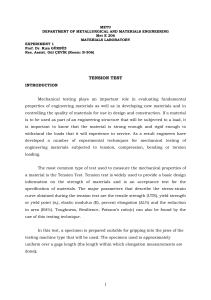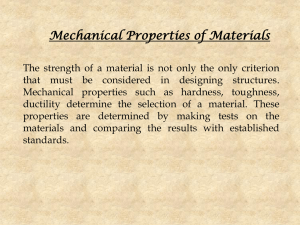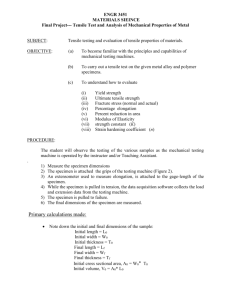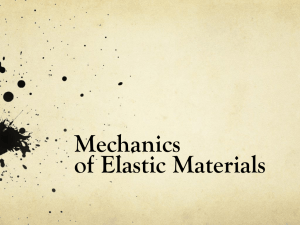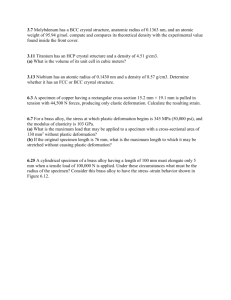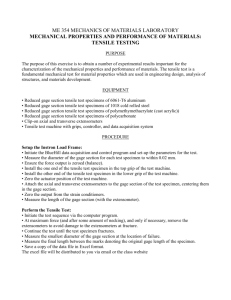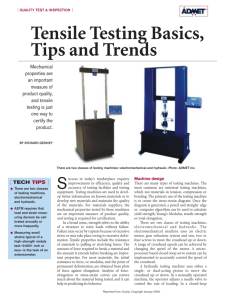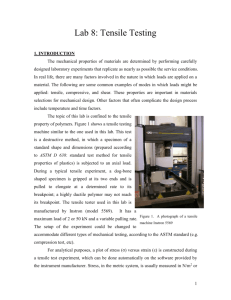1 tension test
advertisement
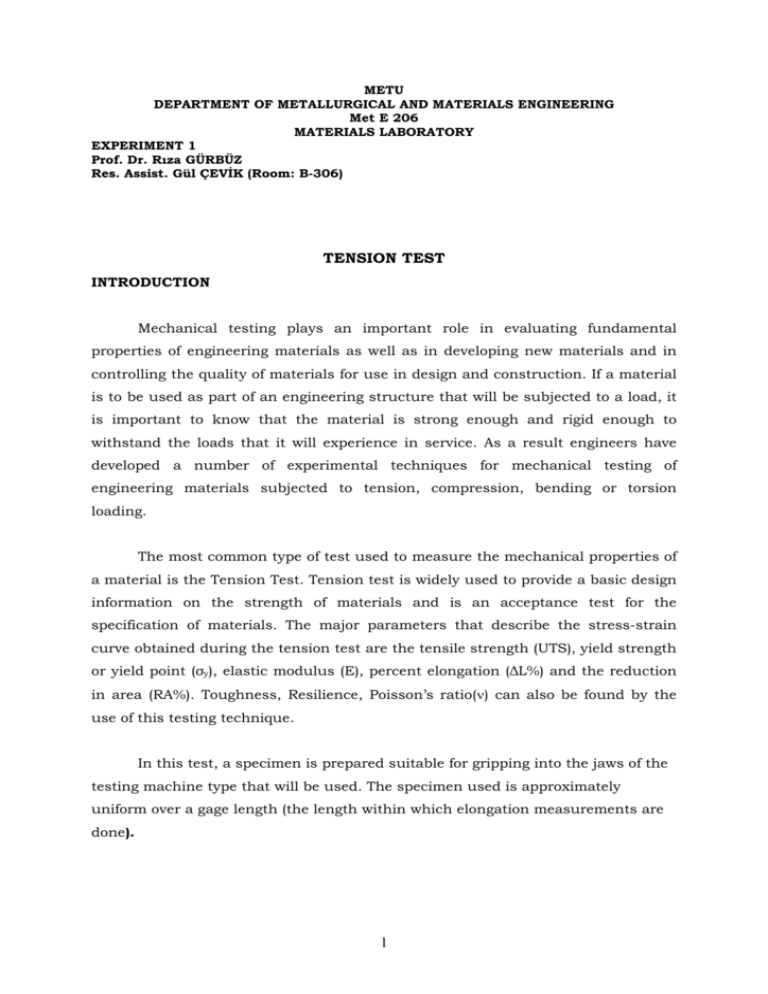
METU DEPARTMENT OF METALLURGICAL AND MATERIALS ENGINEERING Met E 206 MATERIALS LABORATORY EXPERIMENT 1 Prof. Dr. Rıza GÜRBÜZ Res. Assist. Gül ÇEVİK (Room: B-306) TENSION TEST INTRODUCTION Mechanical testing plays an important role in evaluating fundamental properties of engineering materials as well as in developing new materials and in controlling the quality of materials for use in design and construction. If a material is to be used as part of an engineering structure that will be subjected to a load, it is important to know that the material is strong enough and rigid enough to withstand the loads that it will experience in service. As a result engineers have developed a number of experimental techniques for mechanical testing of engineering materials subjected to tension, compression, bending or torsion loading. The most common type of test used to measure the mechanical properties of a material is the Tension Test. Tension test is widely used to provide a basic design information on the strength of materials and is an acceptance test for the specification of materials. The major parameters that describe the stress-strain curve obtained during the tension test are the tensile strength (UTS), yield strength or yield point (σy), elastic modulus (E), percent elongation (∆L%) and the reduction in area (RA%). Toughness, Resilience, Poisson’s ratio(ν) can also be found by the use of this testing technique. In this test, a specimen is prepared suitable for gripping into the jaws of the testing machine type that will be used. The specimen used is approximately uniform over a gage length (the length within which elongation measurements are done). 1 Gage length (L0) do Tensile specimens (a) rectangular, (b) round Tensile specimens are machined from the material to be tested in the desired orientation and according to the standards. The cross section of the specimen is usually round, square or rectangular. For metals, a piece of sufficient thickness can be obtained so that it can be easily machined, a round specimen is commonly used. For sheet and plate stock, a flat specimen is usually employed. The change in the gage length of the sample as pulling proceeds is measured from either the change in actuator position (stroke or overall change in length) or a sensor attached to the sample (called an extensometer). According to the loading type, there are two kinds of tensile testing machines; 1 – Screw Driven Testing Machine: During the experiment, elongation rate is kept constant. 2 – Hydraulic Testing Machine: Keeps the loading rate constant. The loading rate can be set depending on the desired time to fracture. A tensile load is applied to the specimen until it fractures. During the test, the load required to make a certain elongation on the material is recorded. A loadelongation curve is plotted by an x-y recorder, so that the tensile behavior of the material can be obtained. An engineering stress-strain curve can be constructed from this load-elongation curve by making the required calculations. Then the mechanical parameters that we search for can be found by studying on this curve. 2 A typical engineering stress-strain diagram and the significant parameters are shown on the figure in appendix. Engineering Stress is obtained by dividing the load by the original area of the cross section of the specimen. Stress σ = P/Ao ( Load/Initial cross-sectional area) Strain = e = ∆l/lo (Elongation/Initial gage length) Engineering stress and strain are independent of the geometry of the specimen. Elastic Region: The part of the stress-strain curve up to the yielding point. Elastic deformation is recoverable. In the elastic region, stress and strain are related to each other linearly. Hooke’s Law: σ = Ee The linearity constant E is called the elastic modulus which is specific for each type of material. Plastic Region: The part of the stress-strain diagram after the yielding point. At the yielding point, the plastic deformation starts. Plastic deformation is permanent. At the maximum point of the stress-strain diagram (σUTS), necking starts. Tensile Strength is the maximum stress that the material can support. σUTS = Pmax/Ao Because the tensile strength is easy to determine and is a quite reproducible property, it is useful for the purposes of specifications and for quality control of a product. Extensive empirical correlations between tensile strength and properties such as hardness and fatigue strength are often quite useful. For brittle materials, the tensile strength is a valid criterion for design. 3 Yield Strength is the stress level at which plastic deformation starts. The beginning of first plastic deformation is called yielding. It is an important parameter in design. The stress at which plastic deformation or yielding is observed to begin depends on the sensitivity of the strain measurements. With most materials there is a gradual transition from elastic to plastic behavior, and the point at which plastic deformation begins is hard to define with precision. Various criteria for the initiation of yielding are used depending on the sensitivity of the strain measurements and the intended use of the data. 0,2% off-set method is a commonly used method to determine the yield stength. σy(0.2%) is found by drawing a parallel line to the elastic region and the point at which this line intersects with the stress-strain curve is set as the yielding point. An illustration of 0,2% off-set method is shown in the appendix part. Ductility is the degree of plastic deformation that a material can withstand before fracture. A material that experiences very little or no plastic deformation upon fracture is termed brittle. In general, measurements of ductility are of interest in three ways: 1. To indicate the extent to which a metal can be deformed without fracture in metalworking operations such as rolling and extrusion. 2. To indicate to the designer, in a general way, the ability of the metal to flow plastically before fracture. 3. To serve as an indicator of changes in impurity level or processing conditions. Ductility measurements may be specified to assess material quality even though no direct relationship exists between the ductility measurement and performance in service. Ductility can be expressed either in terms of percent elongation (z) or percent reduction in area (q) ; z = %∆l = [(lf-lo)/lo]*100 q = %RA = [(Ao-Af)/Ao]*100 4 Resilience is the capacity of a material to absorb energy when it is deformed elastically. Toughness is a measure of energy required to cause fracture. Poisson’s Ratio is the lateral contraction per unit breadth divided by the longitudinal extension per unit length. ν =-( ∆d/do)/(∆l/lo) OBJECTIVE Tension test is carried out; to obtain the stress-strain diagram, to determine the tensile properties and hence to get valuable information about the mechanical behavior and the engineering performance of the material. TESTING SYSTEM The testing system consists of a tensile testing machine, a load cell, a power supply and an x-y recorder. Testing Machine is of hydraulic type (Alşa Universal Testing Machine). It is a load-controlled machine. Load Cell provides an electrical circuit for measuring the instantaneous load along the loading axis. Power Supply is connected to load cell. It feeds the load cell, amplifies the output signal and displays the load. Recorder plots the variation of load against time. SPECIMEN As mentioned previously, tensile specimens are machined in the desired orientation and according to the standards. The central portion (gage portion) of the length is usually of smaller cross section than the end portions. This ensures the failure to occur at a section where the stresses are not affected by the gripping device. The gage length is marked and elongation is measured between these markings during the test. 5 PROCEDURE Before the test 1. Put gage marks on the specimen 2. Measure the initial gage length and diameter 3. Select a load scale to deform and fracture the specimen. Note that that tensile strength of the material type used has to be known approximately. During the test 1. Record the maximum load 2. Conduct the test until fracture. After the test 1. Measure the final gage length and diameter. The diameter should be measured from the neck. ASSIGNMENTS 1. Tabulate the data obtained during the test 2. Plot the load versus elongation curve on a milimetrical paper. Make scales for both x and y axis. Label the known values 3. Plot the engineering stress-strain curve on a milimetrical paper. Make scales for both x and y axis. Label the known values. 4. Calculate the strength parameters; a. Yield stress (0.2 % off-set), σy [MPa] b. Young’s modulus, E [Gpa] c. Ultimate tensile strength, UTS [MPa] d. Fracture Stress, σF [MPa] 5. Calculate the critical strains; a. yielding strain, ey b. Strain at onset of neck (UTS strain), eUTS c. Fracture strain, ef 6. Calculate the ductility parameters; 6 a. Percent elongation, %∆L b. Percent reduction in area, %RA 7. Calculate the energy parameters a. Resilience, UR; the elastic energy in J. b. Toughness,UT; the total energy absorbed by the specimen in J. 8. Calculate the Poisson’s ratio assuming the volume is constant during elastic deformation. 9. Tabulate your results P.S: Since all the laboratory work will be held on the lab. hour, do not forget to bring your calculators and rulers to the laboratory. Also at least a number of 2 milimetrical papers will be necessary for the laboratory work! APPENDIX A typical Stress- Strain Diagram for a Ductile Material e 7 0,2% Off-Set Method for Determining the Yield Strength σ σy0,2 e =0,2% e Typical engineering stress-strain behavior to fracture, point F. The tensile strength is indicated at point M. The circular insets represent the geometry of the deformed specimen at various points along the curve. 8 REPORT FORMAT 1. Introduction & Theory 2. a. Objective b. Specimen type, shape and dimensions c. Testing System 3. Experimental Procedure: Explain how we conducted the tension test, step by step. 4. Assignments: Calculate the parameters listed on the assisgnments part. Show your calculations. Make explanations about your calculations. 5. Conclusion and Discussion: Comment on the results. Compare the parameters you have calculated with the theoritical ones of the material you have used. Comment on the use and importance of tension test. 6. References. 9
